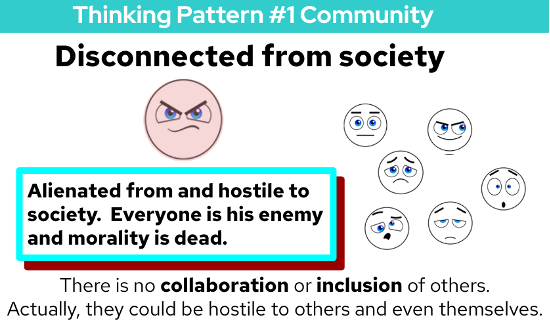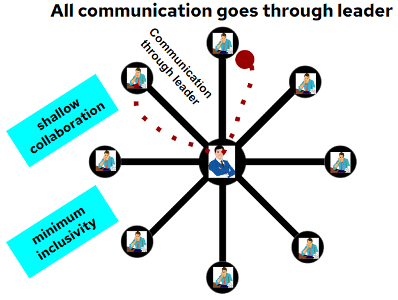I recently studied some research by Dave Logan, Bob King, and Halee Fischer-Wright, who looked at what I call productive and counterproductive communities. Community is an important open organization principle. These researchers define it as a group of 20 to 150 people who know each other enough to say hello on the street and influence or impact each other. They give suggestions on guiding people out of counterproductive communities and relationships and into productive ones through introductions to people who have gone through that process.
Their study suggests many of the same collaboration concepts I talked about in my article on the book Team of Teams: New Rules of Engagement for a Complex World. The context between the two studies is very different, but they both come to similar conclusions about the flow of communication (here again, the open organization principle is widely applied).
The researchers believe that cultures determine a common dominant language, topics of conversation, feelings, and behavior. It's what determines the environment you live and work in. You are either energizing or draining people of their energy (consuming their energy and motivation). A group eventually expels those that speak a different language or behave unacceptably.
According to the researchers, the effectiveness of a community is based on five stages of culture:
- Counterproductive to the members themselves and their surrounding society.
- Barely productive.
- Generally productive.
- Very productive.
- Extremely productive.
Each stage represents a specific way that a community thinks, behaves, and speaks.
#1 is the most pessimistic environment, and #5 is the most optimistic. As a leader, your job is to encourage members to leave #1 and join #5. I discuss community cultural thinking patterns #1-3 in part one of this article and thinking patterns #4-5 in part two. I also include a fictional account of a person moving through all five patterns.
What community members talk about and how they speak to each other determines which of the five community thinking patterns they are in. Larger communities could have several sub-community thinking patterns in play at the same time.
What is community leadership?
When you're a community leader, you have the respect and trust of the community. You are guiding the community, and you must consider two main aspects of it.
The first aspect is the ever-changing forward and backward behavior of each member. What are you doing to move the purpose of the community forward (not backward)? Your full attention is on measurable performance, not simple beliefs or attitudes. Leaving the community might be a good option if you cannot improve the community's greater good purpose.
The second aspect is how you communicate and speak within the culture or community. The researchers believe each of the five cultural thinking patterns has its own language and way of speaking and behaving. That culture must pass through each of the five thinking patterns toward more productivity. The language and behavior you encourage determine advancement. Your goal is to improve the language and move the behavior in a more productive direction.
As you guide the community, the community also guides you. It can be either supportive or resistant. This interaction determines the pace of community advancement and forces you to adapt where appropriate or simply to leave the community altogether.
With that understanding, you can introduce members to others that want to be more productive and those that have gone through similar development issues. You redirect questions to continue discussions and turn praise toward the community members themselves.
Behavior and outwardly or quietly spoken attitudes
With those thoughts, according to the researchers, a community leader listens to the language within the culture and attempts to move the community to the next higher cultural thinking pattern.
As a leader, you must discourage one type of behavior and language, replacing it with another. If a member is unwilling to change either language or conduct, that community member might have to be removed from the community.
These community thinking patterns can be seen through current behaviors and what people say. They are not fixed situations but evolve over time. The researchers have learned that behaviors can go up and down and continually move in strength and intensity when closely observed (never, rarely, occasionally, often, always).
Community thinking pattern #1 environment
According to the researchers, the people in this thinking pattern are alienated from others but believe that "misery loves company," and this is their family. "Life is miserable," but everyone is in it together. The community's feeling and behavior expresses despair and hostility. Members are abusive and could be violent to others and even self-destructive.
In a business setting, these people could steal quietly from their company and feel no shame when caught.
In terms of collaboration, they feel so alienated from everyone that they don't interact with people at all.
Feelings within early community thinking pattern #1

(Ronald McFarland, CC BY-SA 4.0)
This person believes all bad behavior is justified, and everyone acts this way.
What is the job of the community introducer-in-chief? According to the researchers, you have to identify people who want to improve their situation and are willing to work on it. Then, you convince these people that they have the choice to improve themselves and their situation. You might introduce them to a community member who used to be in similar circumstances.
Community thinking pattern #2 environment

(Ronald McFarland, CC BY-SA 4.0)
These community members (and collective culture) think that others have power they lack. They feel trapped and that their life is terrible. The researchers reflect the feeling, "my life is miserable."
These people form groups that complain about their environment and community. They feel like victims and therefore do the minimum to get by. In a business setting, these people do what the job requires and no more. They are good at pretending to be busy. They believe they can't be creative in their work, so they're disengaged. In terms of collaboration, they feel separated from anyone in authority.
First, identify this behavior and language (usually, some variation on "my life is miserable"). As the introducer-in-chief, you can direct the person to individuals who may be helpful, particularly others who have recently struggled with their own life challenges but have been successful and want to continue progressing.
Encourage one-on-one interactions between those two people, so the two can find a way forward. The leader should encourage the person to do this repeatedly with many people, as there is never one path, and everyone is different. If people have gone through similar problems, they are often very happy to mentor others.
Through these one-on-one discussions, a vision forward can surface. People can find their strengths through these discussions. Also, other support resources might come to mind. Even skill development activities that address weaknesses can be explored. Together they can consider easy, quick-reward projects that achieve something and build skills and confidence along the way. These projects should be self-paced to ensure they are energizing and not exhausting.
If you're successful, the person starts to use positive language and exhibits skills others don't have. A small sense of superiority may even develop in specific areas when compared with other people.
Feelings within early community thinking pattern #2
In the new environment, this person sees potential, not yet fully realized but getting nearer. A person fears going backward in early community thinking pattern #2. They do one of these things:
- Find a thinking pattern #2 community and stay there.
- Adjust their attitude.
- Revert to their previous bitter lifestyle and environment.
The job of the community introducer-in-chief is to identify people who are willing to work to improve their situation. Next, introduce those people to individuals who have struggled with the same feelings and environment but have learned ways to be personally successful.
Feelings within middle community thinking pattern #2
These people tend to attract other thinking pattern #2 people, share a similar attitude of being outside the main decision-making action, and jointly complain about something keeping them from advancing. They accept that as unavoidable and like to mock their bad bosses.
Feelings within late community thinking pattern #2
These people feel life is miserable but badly want to move to a better life. They think having an unsatisfying life is temporary and believe it can improve. From this point, it's possible to move to the next thinking pattern.
Community thinking pattern #3 environment
These people (and their collective culture) are individually high performers and are extremely skilled in their area of specialty. They work in one-to-one relationships to get others to help them personally advance.
Their attention is not particularly concerned with others or the community overall. In the researcher's words, "I'm great" (and indirectly, "you're not") is the predominant feeling. You often hear "I," "me," and "my" from these people, according to the researchers.
In relationships with other people, these community members consider others as competitors. Sometimes, they hide attacks on others through humor. In any situation, their goal is to control and dominate others. They attract community thinking pattern #2 people that are just willing to take orders and do no more.
Regarding collaboration, they only discuss issues individually with their personal goals in mind. Furthermore, they tend to hoard information and are not inclusive or transparent.
According to the researchers, a common complaint heard from these people is that they never have enough time to get things done, and they want to achieve far more than they currently do. Also, they consider many around them uncooperative, poorly skilled, or unmotivated. After identifying this behavior and how the person speaks, the introducer-in-chief's action plan should encourage the person to work in larger groups (three-person groupings on a given project) and not one-on-one only. Introduce like-minded people to each other, and enable them to help one another.
Encourage the person to work on projects they cannot achieve alone but could with the right community. They should work on projects that require partnerships.
The researchers believe these community members must be convinced that their talent can only get them so far. Through working with others, far more can be achieved. The increased power comes not from added ability but from wide-ranging networks that have both knowledge and usable skills.
This network development can be achieved by being more transparent with what is known. This approach stimulates others to be transparent and to reach for greater achievements.
Feelings within early community thinking pattern #3
According to the researchers, these people found abilities they could develop. Working on those skills alone, they get praise for their progress. They feel there is more to be done and that only they can do it successfully.
Secretly, they're still uncertain about how well they perform, feeling they have to prove themselves to others (and themselves). Furthermore, they feel they are only worth as much as their performance. On good days, they feel confident. On bad days, they feel stuck, powerless, and out of control (which leads back to feelings of community thinking pattern #2).
They are the most comfortable working with people with the same talent, skills, and drive as they have.
A key difference between community thinking patterns #2 and #3 is a passion for personal success and self-reliance, as opposed to a feeling of powerlessness.
Feelings within middle community thinking pattern #3
There's a transition to the middle of community thinking pattern #3 that happens when people find a group that accepts them for their gifts and skills. Sometimes, it is a mentor who offers this respect that is needed. Over time, a more solid community support system stabilizes with others with similar skills, performance, and professional drive.
These people find others with similar skills in the same specialty or equivalent skills in other specialties. Generally, the group has a similar level of professional confidence. This leads to a mild level of competition or one-upmanship among them. They respect each other within a competitive atmosphere.
They expect others to have the same drive as they have and are disappointed when others don't put in the same effort. They will likely transition into management at this point, warranting their own staff.
Feelings within late community thinking pattern #3
The late stage of community thinking pattern #3 level is when a person maintains a one-on-one relationship with other workers (often their staff) and has a strong management style. They give orders and confirm that tasks have been completed. They discourage staff from discussing things with each other without a leader in attendance.

(Ronald McFarland, CC BY-SA 4.0)
These managers always complain that there is not enough time to do what needs to be done. They are either doing things directly or running around supervising countless staff activities.
The community introducer-in-chief's job is to identify people who want to improve performance and work with other people. As the introducer-in-chief, ask managers to let go of control. Have the managers let their staff work directly with each other. Start by introducing two people to each other, and then step aside and let those two work together.
It's at this point that the principles of the Open Organization come into play.
Patterns #4 and #5
Part 2 of this article discusses cultural thinking patterns #4 and #5. It also provides an example of how introducers can influence an individual and lead them toward the next more positive community.






2 Comments